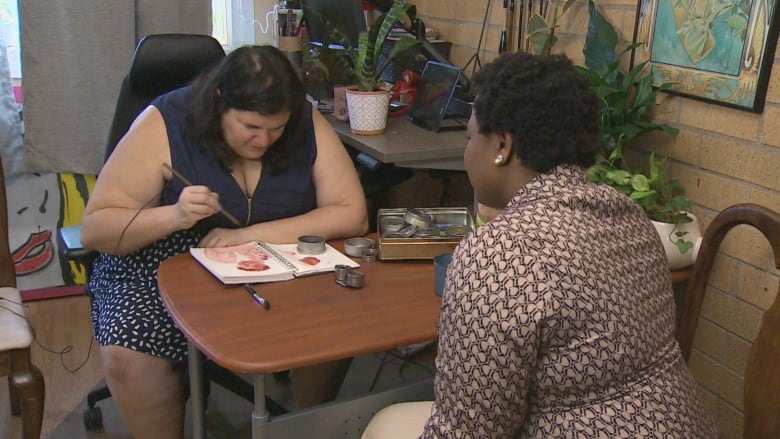Born visually impaired in Grand-Barachois, a small eastern New Brunswick community on the Northumberland Strait, Ysabelle Vautour connects with herself — and with others — through art.
Now living in Fredericton, Vautour’s disability not only inspired her to pursue a career in visual arts, but it also prompted her to create a safe space for other disabled artists in New Brunswick.
Her visual impairments include colour-blindness, photosensitivity and 20/200 vision.
“So most people they have 20/20 vision and mine’s like 20/200,” she said. “So whatever you see at 200 feet, I have to like go to 20 feet to see the same thing that you’re seeing.
“I never thought that the way I see is bad,” she said. “For me it’s fine. I was always a very creative person in school.”

Vautour said she hopes to use her art to educate people and change their perceptions.
“People ask me questions about the visual impairment because I do visual art … I could have hidden that fact, but I thought it was important because it affects the artwork,” says Vautour.
Featured VideoBy focusing on how the process makes her feel rather than the outcome, artist Ysabelle Vautour connects with herself and others through art.
She first started painting for personal reasons — to make herself feel good and autonomous when she felt her job was no longer providing that. But she soon became more passionate about painting, and challenged herself to further develop her skills.
Although she didn’t attend art school, Vautour said she watched YouTube videos and attended as many art events as she could.
“I’m just really surprised about the amount of opportunities that it’s given me. Like last year I was able to travel all across New Brunswick from festival to festival.” she said.

‘It almost talks back to you’
Vautour’s art is mainly inspired by her love for people and their faces.
“I really like people. The fact that I don’t see very well, I tend to take a lot of pictures, so that I can zoom in and it’s very easy to zoom in on the face,” she said.
“And the face is kind of like a complete thing and it’s the most interesting part, sometimes if I’m feeling an emotion it almost talks back to you.”
Vautour chooses to paint with plain colours in boldly-labelled containers and is more focused on how the painting process makes her feel than its outcome. Other times she asks people to help her identify colours or to give feedback on her initial drawings.
Community building
In 2021 Vautour started the New Brunswick Disability Art Collective. The group now has more than 50 members from across the province who advocate and celebrate disability culture through the arts.
She said the group is made up of photographers, painters, musicians, poets, writers, graphic designers, comedians, writers, textile artists and more.
Painter and group member Cass Maz said meeting Vautour and joining the group is “nice because when you get there you get more purposeful ideas.”

Maz, who uses a wheelchair, said she had a stroke in 2013 that resulted in a number of chronic health conditions including involuntary muscle movement, twitching eyes, high blood pressure, motor speech disorders and numbness on her left side.
She started painting after meeting the instructor of her 26th birthday sip-and-paint party.
“The artist that came showed us some different techniques to make a picture and I was surprised,” she said.
“So I went on the internet like YouTube and was looking for different techniques I could use for painting and I found a bunch and I just kept painting.”

Vautour has now had her art showcased in several Canada cities and had her first solo show at the Charlotte Street Arts Centre in Fredericton.
For her, becoming a visual artist has helped her reconnect with herself. She hopes her art becomes more accessible to everyone and their perception of disability art becomes more accepting.
“It’s kind of like writing in a diary … it feels good,” she said.

